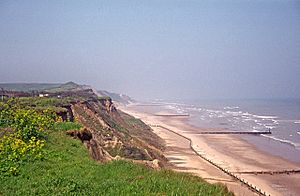Overstrand Cliffs facts for kids
| Site of Special Scientific Interest | |
 |
|
| Area of Search | Norfolk |
|---|---|
| Interest | Biological Geological |
| Area | 57.8 hectares (143 acres) |
| Notification | 1992 |
| Location map | Magic Map |
Overstrand Cliffs is a really special place in Cromer, Norfolk, England. It covers about 57.8 hectares (that's like 143 football fields!). This area is important for two main reasons: its amazing wildlife (biological) and its incredible history told in the rocks (geological).
Because it's so unique, Overstrand Cliffs is protected as a Site of Special Scientific Interest (SSSI). This means it's a place where scientists can study nature and history. It's also a Special Area of Conservation, which is an even bigger protection for important habitats in Europe. Plus, part of it is a Geological Conservation Review site, meaning it's super important for understanding Earth's past.
Contents
What Makes Overstrand Cliffs Special?
Overstrand Cliffs is a fascinating place where nature is always changing. The cliffs here are made of soft rock, which means they can crumble and slide down. This natural process, called "falls and slumping," might sound a bit messy, but it actually creates a perfect home for some very rare and interesting creatures.
Amazing Animals and Plants
The constant changes on the cliffs create a special kind of habitat (a natural home) for certain animals. These animals love places that are often disturbed, meaning their environment is always shifting.
- Rare Beetles: You might not think of beetles as exciting, but Overstrand Cliffs is home to some very rare ones! These include the Bledius filipes, Harpalus vernalis, and Nebria livida beetles. They thrive in the loose soil and fresh surfaces created by the crumbling cliffs. It's like their perfect playground!
A Look Back in Time: Geology
The cliffs at Overstrand are like a giant history book made of rock. They are incredibly important for geologists (scientists who study rocks and the Earth).
- Ice Age Clues: The different layers of rock in the cliffs show a clear record of the Pleistocene epoch. This was a time when huge ice sheets, called glaciers, covered much of the Earth. By studying these "glacial exposures," scientists can learn about how the ice ages affected the landscape and what the climate was like thousands of years ago. It's like looking at old photographs of Earth's past!
Visiting Overstrand Cliffs
The beach at Overstrand Cliffs is open for everyone to enjoy. It's a great place to walk, explore, and see the amazing natural processes happening right before your eyes. Just remember to be respectful of this special place and its unique wildlife and geology.

